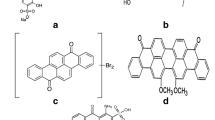Abstract
In this study, Gonium sp. was investigated for possible usage in dye-containing wastewater treatment. Trials were performed in media including triacontanol hormone, Reactive Orange 14, Reactive Red 120, Reactive Black 5, Remazol Brilliant Blue R (RBBR), and also hormone against the controls. Algae could remove RBBR with the highest dye removal percentage (56%) among the tested dyes. The optimum pH was 9 in removing 50 mg L−1 RBBR at a dye removal percentage of 47.1%. The role of laccase activity of Gonium sp. was also investigated. This first attempt in the literature showed the involvement of the enzyme in the algal growth and bioremoval process. In the presence of the plant growth hormone in the culture, the activity showed a steady and significant increase up to nearly sixfold between 5th and 14th days of incubation.



Similar content being viewed by others
References
Acuner, E., & Dilek, F. B. (2004). Treatment of tectilon yellow 2 G by Chlorella vulgaris. Process Biochemistry, 39, 623–631.
Bourbonnais, R., & Paice, M. G. (1990). Oxidation of non-phenolic substrates, an expanded role for lactase in lignin biodegradation. FEBS Letters, 267, 99–102.
Chen, X., Yuan, H., Chen, R., Zhu, L., Du, B., Weng, Q., et al. (2002). Isolation and characterization of triacontanol-regulated genes in rice (Oryza sativa L.): possible role of triacontanol as a plant growth stimulator. Plant & Cell Physiology, 43, 869–876.
Couto, R. S., & Herrera, J. T. (2006). Industrial biotechnological applications of laccases: a review. Biotechnology Advances, 24, 500–513.
Dilek, F. B., Taplamacioglu, H. M., & Tarlan, E. (1999). Colour and AOX removal from pulping effluents by algae. Applied Microbiology and Biotechnology, 52, 585–591.
Dönmez, G. (2002). Bioaccumulation of the reactive textile dyes by Candida tropicalis growing in molasses medium. Enzyme and Microbial Technology, 30(3), 363–366.
Forgacs, E., Cserháti, T., & Oros, G. (2004). Removal of synthetic dyes from wastewaters: a review. Enviromental International, 30, 953–971.
Gianfreda, L., Feng, X., & Jean-Marc, B. (1999). Laccases: a useful group of oxidoreductive enzymes. Bioremediation Journal, 3, 1–26.
Houtz, R. L., Ries, S. K., & Tolbert, N. E. (1985). Effect of triacontanol on Chlamydomonas. II. specific activity of ribulose-bisphosphate carboxylase/oxygenase, ribulose-bisphosphate concentration, and characteristics of photorespiration. Plant Physiology, 79, 365–370.
Karacakaya, P., Kılıç, N. K., Duygu, E., & Dönmez, G. (2009). Stimulation of reactive dye removal by cyanobacteria in media containing triacontanol hormone. Journal of Hazardous Materials, 172, 1635–1639.
Kılıç, N. K., Nielsen, J. L., Yüce, M., & Dönmez, G. (2007). Characterization of a simple bacterial consortium for effective treatment of wastewaters with reactive dyes and Cr(VI). Chemosphere, 67(4), 826–831.
Lansheng, L., Xiuhai, W., Ying, L., Juan, A., Fengmin, L., Xianlong, H. (2008). Allelopathic effects of triacontanol on the growth of marine photosynthetic bacteria. Allelopathy Journal 21, Online ISSN, 0973–5046.
Lim, S.-L., Chu, W.-L., & Phang, S.-M. (2010). Use of Chlorella vulgaris for bioremediation of textile wastewater. Bioresource Technology, 101, 7314–7322.
Lima, S. A. C., Raposo, M. F. J., Castro, P. M. L., & Morais, R. M. (2004). Biodegradation of p-chlorophenol by a microalgae consortium. Water Research, 38(1), 97–102.
McCutcheon, S. C., & Schnor, J. L. (2004). Overview of phytotransformation and control of wastes. In S. C. McCutcheon & J. L. Schnoor (Eds.), Phytoremediation transformation and control of contaminants. New York: Wiley Interscience.
Oswald, W. J. (2003). My sixty years in applied algollogy. Journal of Applied Phycology, 15, 99–106.
Palanisami, S., Saha, S. K., & Lakshmanan, U. (2010). Laccase and polyphenol oxidase activities of marine cyanobacteria: a study with Poly R-478 decolourization. World Journal of Microbiology & Biotechnology, 26, 63–69.
Park, C., Lim, J.-S., Lee, Y., Lee, B., Kim, S.-W., Lee, J., et al. (2007). Optimization and morphology for decolorization of reactive black 5 by Funalia trogii. Enzyme and Microbial Technology, 40, 1758–1764.
Pereira, M. J., Resende, P., Azeiteiro, U. M., Oliveira, J., & de Figueiredo, D. R. (2005). Differences in the effects of metals on growth of two freshwater green algae (Pseudokirchneriella subcapitata (Korshikov) Hindak and Gonium pectorale Müller). Bulletin of Environmental Contamination and Toxicology, 75, 515–522.
Ries, S. K., & Stutte, C. A. (1985). Critical regulation of plant growth with triacontanol. Critical Reviews in Plant Science, 2, 239–285.
Rippka, R. (1988). Isolation and purification of Cyanobacteria. Methods in Enzymology, 167, 3–27.
Robinson, T., McMullan, G., Marchant, R., & Nigam, P. (2001). Remediation of dyes in textile effluent: a critical review on current treatment technologies with a proposed alternative. Bioresource Technology, 77, 247–255.
Sadettin, S., & Dönmez, G. (2006). Bioaccumulation of reactive dyes by thermophilic cyanobacteria. Process Biochemistry, 41(4), 836–841.
Saha, P. (2010). Assessment on the removal of methylene blue dye using tamarind fruit shell as biosorbent. Water, Air, and Soil Pollution, 213, 287–299.
Author information
Authors and Affiliations
Corresponding author
Rights and permissions
About this article
Cite this article
Kılıç, N.K., Karatay, S.E., Duygu, E. et al. Potential of Gonium spp. in Synthetic Reactive Dye Removal, Possible Role of Laccases and Stimulation by Triacontanol Hormone. Water Air Soil Pollut 222, 297–303 (2011). https://doi.org/10.1007/s11270-011-0824-7
Received:
Accepted:
Published:
Issue Date:
DOI: https://doi.org/10.1007/s11270-011-0824-7




